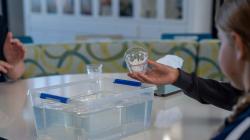Change detectives addresses AC Science Understanding ACSSU095 Changes to materials can be reversible or irreversible, through the context of becoming crime scene investigators, identifying and explaining physical and chemical changes to everyday materials.
Explore our new sequences for Year 6 aligned to AC V9
Change detectives provides students with hands-on opportunities to:
- investigate if melted or frozen objects can be returned to their original state
- observe the factors that make materials melt most quickly
- role-play the behaviour of solids, liquid and gases
- explore factors relating to evaporation
- investigate how solids can be dissolved in liquids, if this process is reversible and any reaction that may occur
- explore what happens when candles are burnt
Students apply their new learning by:
- planning and conducting an investigation on factors that affect the time it takes for a fizzing tablet to dissolve in water
Linking science with literacy
In the Primary Connections approach, students are supported to create representations that draw on and strengthen their literacy development. In Change detectives, students represent and explain their understanding about how changes to materials can be reversible or irreversible, by creating these representations:
- Graph
- Procedural text
- Report
- Role play
- Summary
- Data table
- Venn diagram
- Word wall
This is a classic Primary Connections sequence aligned with the Australian Curriculum V8.4. It is only available as a downloadable package.
The Change detectives sequence package includes all the resources you need to teach this sequence, including:
- The Change detectives unit PDF
- Sample photos for use in activities
- Equipment list
- Australian Curriculum v8.4 alignment
- Student eResource sheets
- Assessment resources:
- Assessment rubrics
- Work samples
- Student self-assessment
- Achievement standard class checklist
Teacher tools
Our new all-online sequence Communicating matters shares a curriculum content descriptor with this sequence. Communicating matters is aligned to the Australian Curriculum V9 and contains embedded professional learning and supplementary teacher advice.
Communicating matters
Students learn about solids, liquids and gases, determine their properties and consider how their particulate arrangement relates to their properties and behaviour. They study science communication to communicate what they have learned.

